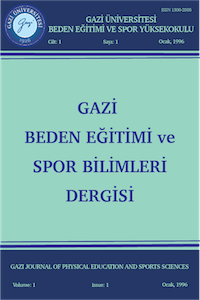ARTAN DIRENÇ EGZERSIZLERI VE GENEL MAKSÎMAL KUVVET ANTRENMANLARıNıN KUVVET GELIŞIMI, ISTIRAHAT NABZı, KAN BASıNÇLARı, AEROBIK-ANAEROBIK GÜÇ VE VÜCUT KOMPOZISYONUNA ETKILERI
Abstract
Keywords
Kuvvet vücut kompozisyonu aerobik-Anaerobik güç İstirahat nabzı Sistolik-Diastolik kan basıncı
References
- Astrand P.O., Rodalh, K. (1986). Textbook of Work Physiology, Third Edition, Newyork: Mc Graw-Hili Book Company, 342-343.
- Brown R.D., Hardson, J.M. (1968). The effects of strength training pogram on the strenght and self-concept of two female ag group. Research Quarterly for Exercise and Sport, 4 (1), 315-320.
- Cısar, J.C., Thorland, W.G. (1989). Yearly changes in the body colposrtfon and muscular strengah of high school wrestlers. Research Quarterly for Exercise and Sport, (3), 239-245.
- Clarkson, M.P. (1982). The relationship among isokinetic endurance, ınıtel strength level and fiber type. Reseacrh Ouanteriy for Exercise and Sport, 53 (1 ), 127-131.
EFFECTS OF PROGRESSIVE RESISTANCE AND MAXIMAL STRENGTH EXERCISES ON STRENGTH DEVELOPMENT, RESTING HEART RATE, BLOOD PRESSURE, AEROBIC-ANAEROBIC POWER AND BODY COMPOSITION
Abstract
Keywords
Strenght Body Composition Aerobic and Anaerobic power Resting HR Sistotic and Diastolic Blood Pressure
References
- Astrand P.O., Rodalh, K. (1986). Textbook of Work Physiology, Third Edition, Newyork: Mc Graw-Hili Book Company, 342-343.
- Brown R.D., Hardson, J.M. (1968). The effects of strength training pogram on the strenght and self-concept of two female ag group. Research Quarterly for Exercise and Sport, 4 (1), 315-320.
- Cısar, J.C., Thorland, W.G. (1989). Yearly changes in the body colposrtfon and muscular strengah of high school wrestlers. Research Quarterly for Exercise and Sport, (3), 239-245.
- Clarkson, M.P. (1982). The relationship among isokinetic endurance, ınıtel strength level and fiber type. Reseacrh Ouanteriy for Exercise and Sport, 53 (1 ), 127-131.
Details
| Subjects | Sports Medicine |
|---|---|
| Journal Section | Articles |
| Authors | |
| Publication Date | October 15, 1999 |
| Submission Date | August 15, 2017 |
| Acceptance Date | September 15, 1999 |
| Published in Issue | Year 1999 Volume: 4 Issue: 4 |
Gazi Journal of Physical Education and Sports Sciences is a scientific and peer-reviewed journal published quarterly.

